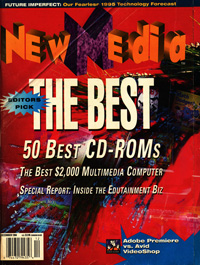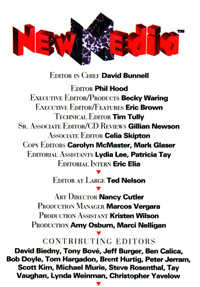|
Vaughan Family Timestream® Maps |
| Home Biography People Places Multimedia: Making It Work On the Water Writings/Presentations |
Ask the Captain
October, 1993
From "Ask the Captain," a monthly column by Tay Vaughan.
New Media Magazine.
Q. Are there any tricks or special software to let me view DOS and Windows CD-ROMs on a Macintosh or vice versa?
Paul Young, Montebello, CA
A. CD-ROMs for DOS and Windows use an accepted International Standards Organization format (ISO 9660) for laying out the table of contents and data files. Macintosh CD-ROMs use Apple's HFS (Hierarchical File Structure) format. Both formats are simply different methods of organizing the digital information contained on the CD-ROM. For example, ISO 9669 limits users to filenames with eight characters and a three character extender (standard DOS convention); HFS allows file names as long as 32 characters (standard Macintosh convention). Hybrid CD-ROMs are made with two separate partitions, one that is ISO 9660, another that is Mac HFS. They will play on both PCs and Macs.
If you are a Macintosh user, you can read a DOS or Windows disc using the ISO 9660 File Access extension supplied by Apple in the CD-ROM Setup system utility package. For text and image files this may be enough, because most word processors will import and translate DOS and Windows files and most image editing programs will import TIFFs and other common PC-formats.
Going the other way, if you are a DOS or Windows user there are currently no good solutions for reading files off a Mac-formatted CD-ROM unless your PC is on a network and the disc resides on a Macintosh CD-ROM player also connected to the network. Your Mac-formatted CD-ROM will generate a "general failure reading..." message if you try to read it on your PC.
On your Macintosh, to actually run an application or a multimedia program designed for DOS or Windows, you will need an emulation program such as Insignia Solution's SoftPC 3.1 (phone 800-8SOFTPC). The Mac keyboard becomes the PC keyboard; the Mac mouse becomes a Microsoft mouse; the Mac printer emulates PostScript and Epson printers. A caution, however: the DOS or Windows application may run slower on your Macintosh because of the processing overhead of the emulator. As usual, the more powerful your Mac CPU, the better the performance.
In response to Steven Rubenstein's question about software to import the digital information from the red book tracks of an audio CD (Ask the Captain, June, 1993), we answered: "Can't do it - the music industry does not want you to mess around with their tunes..."
Optical Media International (800-347-2664) has recently announced Macintosh software called Disc-To-Disk that will perform direct digital-to-digital hard disk recording over the SCSI bus. With it, you can import sounds from an audio CD and create sound files in AIFF/AIFC, .SND, QuickTime Movie, Sound Designer II, and Windows .WAV formats at 8- or 16-bit sampling sizes and 11, 22, or 44.1Khz sampling rates. You must have a Toshiba 3401, Procom MAC-CD-MX, PLI 3401, Apple CD300, Sony CDU-561, or equivalent CD-ROM reader.
---
Q. I want to set up a database for employee ID badges. We would like to include not only pictures, but also a brief recording of the employee's voice. What hardware and software would you recommend for this?
Peter Jenkins, Minneapolis, Minnesota
A. What you want to do is becoming easier and easier, but at the same time, the number of workable solutions is increasing as well, making the selection process for choosing platform and software more complicated.
First, you need database software. Most serious PC and Mac databases will store images and sound clips as objects which can be related to a data record. Claris'(408-727-8227) FileMaker Pro, Microsoft's (206-882-8080) FoxBase, and other even more powerful packages are available for both platforms and for networked environments. Your choice here should depend upon the size of your company and your assessment of how this employee database will be used.
Then you need to gather your multimedia elements and convert them to a digital format that can be managed by your database - you could also include motion video clips as QuickTime or Video for Windows files. This usually means bringing employees to a central location where you do "badging." A digital still color camera such as offered by Dycam (818-998-8008) can be used to create TIFF or PICT images cropped to your requirements; you could also use a video camera and video digitizing hardware to grab still frames. A microphone and audio digitizing software and hardware will also be needed - multimedia PCs and most Macintoshes are set up to record sound. The newest the Centris and Quadra "AV" series Macintoshes have both video and sound digitizing capability built onto the motherboard.
Once your images and sound clips are digitized, your database can deal with them the way it deals with zip codes, telephone numbers, and other text-based information. The toughest part to creating your database lies in the process itself - many little steps may be required to make the images and sounds just right, and often you will need separate applications to perform editing tasks. The photo, for example, might need to be more contrasty and be cropped. The sound file may need editing and fades. If you are creating badges on the spot, you will want a color printer.
All the multimedia hardware and software elements required to do your job neatly and inexpensively are available now; they just haven't been integrated into a single, integrated package for your "vertical market" need. Competitively-priced packages for badging and employee ID management will, without question, be available soon to fill this market niche.
---
Send your questions to TAY c/o NewMedia, 901 Mariner's Island Blvd., Suite 365, San Mateo, Calif. 94404 or send a fax to (415) 573-5131. Writers of published questions will receive a NewMedia T-shirt and prompt answers to their questions. Tay is president of Timestream, Inc,. a CD-ROM and multimedia title production and publishing company, and is author of Multimedia: Making It Work, (Osborne/McGraw-Hill).

